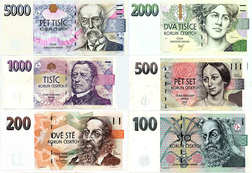Czech koruna
| Czech koruna | |
|---|---|
| koruna česká (Czech) | |

koruna banknotes as of 2014
|
|
| ISO 4217 | |
| Code | CZK |
| Denominations | |
| Subunit | |
| 1/100 | haléř (defunct) |
| Plural | The language(s) of this currency belong(s) to the Slavic languages. There is more than one way to construct plural forms. |
| Symbol | Kč |
| haléř (defunct) | h |
| Banknotes | |
| Freq. used | 100, 200, 500, 1000, 2000 Kč |
| Rarely used | 5000 Kč |
| Coins | |
| Freq. used | 1, 2, 5, 10, 20, 50 Kč |
| Demographics | |
| User(s) |
|
| Issuance | |
| Central bank | Czech National Bank |
| Website | www |
| Valuation | |
| Inflation | 2.2% |
| Source | Czech Statistical Office, January 2017 |
| Method | CPI |
The koruna (sign: Kč; code: CZK) is the currency of the Czech Republic since 1993, and in English it is sometimes referred to as Czech crown. The koruna is one of European Union's 11 currencies, and the Czech Republic is legally bound to adopt the euro currency in the future.
The official name in Czech is koruna česká (plural koruny české, though the zero-grade genitive plural form korun českých is used on banknotes and coins of value 5 Kč or higher). The ISO 4217 code is CZK and the local acronym is Kč, which is placed after the numeric value (e.g., "50 Kč"). One koruna equals 100 haléřů (abbreviated as "h", singular: haléř, nominative plural: haléře, genitive plural: haléřů – used with numbers higher or equal to 5 – e.g. 3 haléře, 8 haléřů), but haléře have been withdrawn, and the smallest unit of currency is 1 kč.
The Czech koruna replaced the Czechoslovak koruna when it was introduced in 1993 after the dissolution of Czechoslovakia. It first consisted of overstamped 20, 50, 100, 500, and 1000 Czechoslovak koruna banknotes, but a new series was properly introduced in 1993.
In November 2013, the Czech National Bank has intervened to weaken the exchange rate of the koruna through a monetary stimulus in order to stop the currency from excessive strengthening. In late 2016, the CNB stated that the return to conventional monetary policy was planned for mid-2017.
...
Wikipedia
